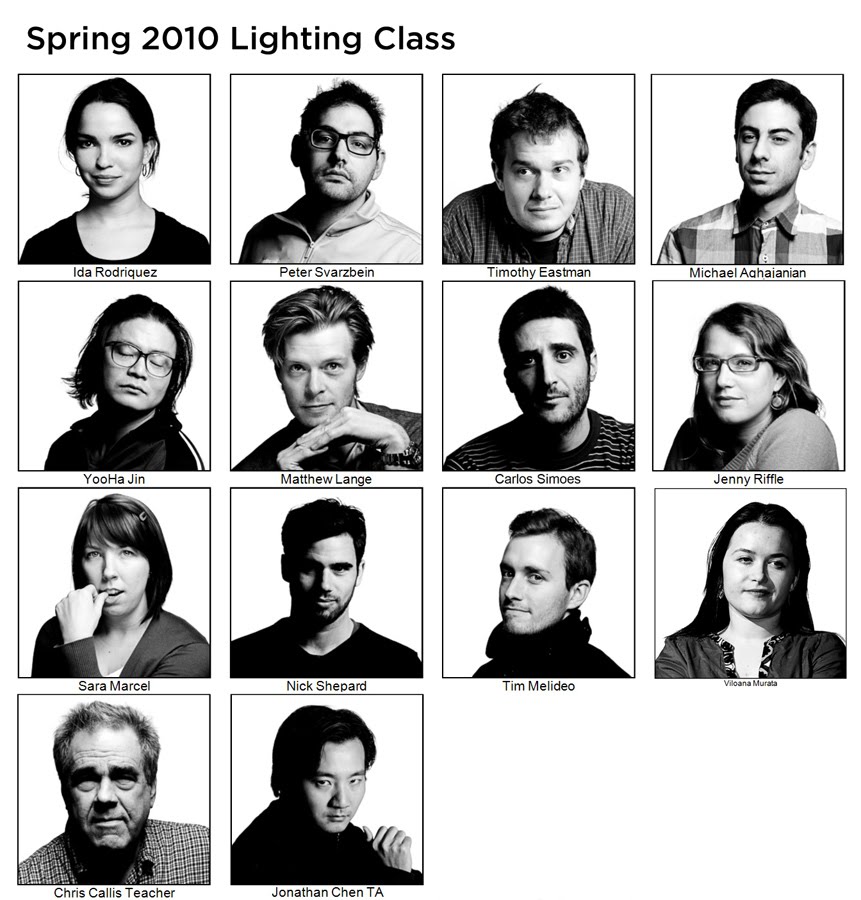 The well oiled machine at work.
The well oiled machine at work.Wednesday, February 24, 2010
Demo 7 Monkey Bar Flat Lighting
This demonstration was to show how to light a large room evenly using 2 packs, 4 heads and 4 softboxes. We ended up using a bare head to light the back portion of the room and used the 4th softbox as a flag. The well oiled machine at work.
The well oiled machine at work.
 The well oiled machine at work.
The well oiled machine at work.Tuesday, February 23, 2010
Tuesday, February 16, 2010
Demo 5 The Use of Feathering when Photographing Groups
Feathering is taking advantage of both the characteristics of the inverse square law and the characteristic that the intensity of the light diminishes toward the edges of the light pattern given off by a particular light source. The closeness of the light to the subject, how it is placed and which direction it is pointed come into play. The light meter is valuable is determing the effectiveness of feathering. By reading the light from left to right and top to bottom then moving the light until the reading are within an acceptable range (I try for a 1/3 stop difference).


Tuesday, February 9, 2010
Demo 4 Grids
Tuesday, February 2, 2010
Demo 3 Canon Wireless System
This demonstration was made using a Canon 1D MII and Canon 580EX II. This combination allows the use of the the External Speedlite Controls on the menu of the 5D MII all the lights can be controlled remotely from this menu.
Pros and Cons of this system:
Pros:
1. Control all lights from the back of the camera
2. No wires
3. Light weight
4. Once set can move light and camera and maintain lighting ratios.
5. Can be used outdoor in bright sunlight and at distances of up to 300 feet with Pocket Wizard Mini TT1 and Flex TT5 system.
6. Can be set manually and still triggered remotely.
7. No light readings necessary.
Cons:
1. Steep learning curve.
2. Reflective light reading can be false depending on the value of the subject.
3. Somewhat expensive.
4. Does not work well in bright sunlight.
5. Limited transmission range and angle of view.
In this 1st demonstration we used the flashs direct and A was on the left, B on the right and we added C on the background.
Pros and Cons of this system:
Pros:
1. Control all lights from the back of the camera
2. No wires
3. Light weight
4. Once set can move light and camera and maintain lighting ratios.
5. Can be used outdoor in bright sunlight and at distances of up to 300 feet with Pocket Wizard Mini TT1 and Flex TT5 system.
6. Can be set manually and still triggered remotely.
7. No light readings necessary.
Cons:
1. Steep learning curve.
2. Reflective light reading can be false depending on the value of the subject.
3. Somewhat expensive.
4. Does not work well in bright sunlight.
5. Limited transmission range and angle of view.
In this 1st demonstration we used the flashs direct and A was on the left, B on the right and we added C on the background.

In the second demonstation we used a mini white translucent umbrella to shoot light through to light the subject and a 42" white umbrella to bound off of for the background light. For the image on the bottom right we used a mini beauty dish on the subject and a snoot on the background.
Subscribe to:
Comments (Atom)













